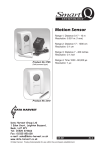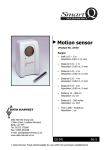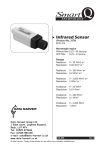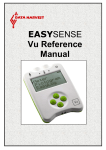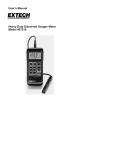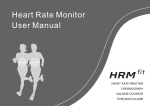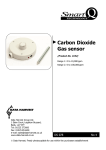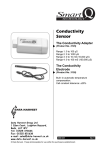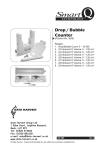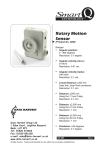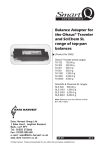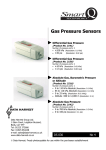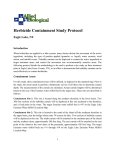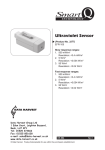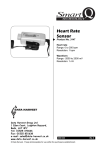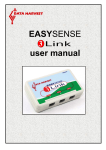Download Oxygen Adapter Oxygen Electrode
Transcript
Smart Q TECHNOLOGY Oxygen Adapter (Product No. 3130) Oxygen Electrode (Product No. 3131) DATA HARVEST Data Harvest Group Ltd 1 Eden Court, Leighton Buzzard, Beds, LU7 4FY Tel: 01525 373666 Fax: 01525 851638 e-mail: [email protected] www.data-harvest.co.uk DS 025 © Data Harvest. Freely photocopiable for use within the purchasers establishment. No 5 Smart Q Oxygen Sensor TECHNOLOGY Contents Introduction . ....................................................................................................1 STEP 1: Preparing the Oxygen electrode........................................................1 STEP 2: Connecting ........................................................................................ 2 STEP 3: Setting the range . ............................................................................. 3 STEP 4: Calibration ........................................................................................ 3 Practical information ........................................................................................ 4 Storage ........................................................................................................ 5 Electrolyte . ...................................................................................................... 5 Cleaning and maintenance............................................................................... 5 Electrode Specification .................................................................................... 6 Theory ........................................................................................................ 6 Converting dissolved oxygen % saturation data to oxygen in mg/l.................. 7 Principles of operation ..................................................................................... 8 Troubleshooting . ............................................................................................. 9 Investigations .................................................................................................. 9 Warranty ........................................................................................................10 Introduction The Smart Q Oxygen Adapter enables an Oxygen electrode to be connected to an EASYSENSE unit. The EASYSENSE unit will detect when the Oxygen Adapter is connected and the range it is set to measure i.e. either % O2 saturation in water or % O2 in air. There are four steps to using the Oxygen Sensor. STEP 1: Preparing the Oxygen electrode The object, when preparing the electrode, is to obtain a thin layer of electrolyte under the membrane covering the anode and cathode without trapping air inside the cell. 0 Ring Silver anode Membrane cap Gold cathode Place the membrane cap, with the membrane downward, on a clean surface. Half fill the cap with the electrolyte supplied. Tap the cap gently to remove any air bubbles from the electrolyte. Note: It is important to remove trapped air bubbles because they will feed oxygen to the cathode and hence cause extra signal current to flow regardless of the oxygen concentration in the sample. Smart Q Oxygen Sensor TECHNOLOGY Hold the electrode body vertically (with the cable uppermost) and screw on the membrane cap. One side of the thread is flat which will allow any surplus electrolyte to escape. Unscrew slightly to release any pressure and then gently screw the cap on until it is just tight. Note: Do not overtighten - the membrane should not be pressurised (bulging away from the cathode tip), as it will become thin and oversensitive. STEP 2: Connecting Smart Q label on the top Calibration knob Sensor cable with locating arrow facing upwards Oxygen electrode with locating arrow facing upwards • • • • • • Hold the Oxygen adapter housing with the Smart Q label showing on the top. Connect one end of the sensor cable (supplied with the EASYSENSE unit)) into the shaped socket on the adaptor with the locating arrow on the cable facing upwards. Connect the other end of the sensor cable to the input socket on the EASYSENSE unit (with the locating arrow facing upwards). Connect the Oxygen electrode into the socket at the other end of the Oxygen Adapter (with the locating arrow facing upwards). The EASYSENSE unit will detect that the Oxygen adapter is connected and display values using the currently selected range i.e. %O2 (in air) or %Sat (in water). If the range is not suitable for your investigation, set to the correct range (see page 3). Leave the adapter and electrode connected to the EASYSENSE unit for at least 30 minutes (preferably 1 hour) to polarise and then calibrate (see page 3) before use. Note: The electrode must be polarised to eliminate any residual oxygen that may be present in the membrane cap - the reading will initially be large and then gradually fall to a stable level. The assembled electrode must stay connected to an EASYSENSE unit to keep it polarised. If disconnected, reconnect for 10 minutes before use. Smart Q Oxygen Sensor TECHNOLOGY STEP 3: Setting the range The Oxygen Sensor can be used to measure either oxygen in the air (0 - 25 %O2) or in water (0 - 125 %Sat). If the currently selected range is not suitable for your investigation the next step is to alter the selected range. • • • • • Connect the Oxygen Sensor to the EASYSENSE unit. Start the EASYSENSE program and select one of the logging modes from the Home page���������������� e.g. EasyLog���. Select Sensor Config from the Settings menu. Select the Oxygen Sensor from the list (it will be listed using its current range) and click on the Change Range button. The current range will be highlighted. Select the required range and click on OK. Close Sensor Config. Click on New and then Finish for the change in range to be detected by the logging mode. The range setting will be retained until changed by the user. With some EASYSENSE units it is possible to change the range from the unit. Please refer to the EASYSENSE unit’s user manual. STEP 4: Calibration Once the correct range has been selected then calibrate the electrode. • To calibrate for use in a Gas e.g. air a. The range of the Sensor should be set to measure oxygen in air, 0 - 25%O2). b. After the Oxygen electrode has been polarised for at least 30 minutes (preferably 1 hour), hold it in the air and display the current value*. c. Turn the knob on the Oxygen Adaptor until a value of 20.9% is shown. • To calibrate for use in an Aqueous solution e.g. water a. The range of the Sensor should be set to measure oxygen in water, 0 - 125 (%Sat). b. After the electrode has been polarised for at least 30 minutes (preferably 1 hour), hold the electrode vertically 10 mm above a sample of stirred distilled water (so the air is saturated with water vapour) for about 60 seconds. Do not let the membrane get wet. c. Display the current value*, then turn the knob on the Oxygen Adaptor until a value of 100% Sat is shown. Electrode 10 mm Stirred distilled water * Note: The current value can be displayed by using Meter on an EASYSENSE unit or Test Mode (from the Tools menu) in the EASYSENSE software. Smart Q Oxygen Sensor TECHNOLOGY Practical information • • • • • • • • • • • • • • The electrochemical reaction within the Sensor removes oxygen from the thin layer of water in contact with the membrane so it is necessary to renew this layer i.e. by moving the Sensor through the water, or by natural water flow or by means of a suitable stirrer. This flow must be induced without the entrapment of air bubbles. Do not touch the membrane or allow it to touch the bottom of a container. Try to keep the electrode vertical during use. If the membrane cap is wet, shake gently to remove residual fluid. Do not use a cloth to dry. When an electrode is placed in a solution, allow to stabilise before starting to record measurements. If you put pH, Oxygen and Conductivity Sensors (electrochemical type) in the same solution at the same time and connected to the same EASYSENSE unit, they can interfere with each other’s signals. Keep the sensors as far apart as possible - the distance required will depend on the conductivity of the solution. If there is still a problem, try connecting the sensors to different EASYSENSE units or take readings using one sensor at a time. The gas permeable membrane isolates the sensor elements from the solution on test but allows the oxygen to enter. This transport can cause the readings to begin to shift after 4 - 5 hours. If possible, recalibrate every two hours. Although the electrode part of the sensor is waterproof, its plug and the Smart Q Oxygen adapter are not waterproof. The Oxygen electrode is supplied with 2 membrane caps, 60 ml of electrolyte and a piece of polishing paper. Further membranes are available as part of the oxygen maintenance kit, Product No. 6172. Treat the membrane carefully as it is fragile. The membrane is PTFE so is very resistant to chemical attack. However it should not be used with wetting agents such as detergents and soaps as they break down surface tension and allow water to pass through the membrane. No grease, oil or organics should come into contact with the membrane. Hydrogen Sulphide (H2S) - a by-product of anaerobic respiration recognised by its rotten egg smell - can be a problem as H2S can pass as a gas through the membrane and attack the silver anode to form Ag2S (a black precipitate). The electrode will not function with this coating, which can be difficult to remove. See cleaning on page 5. The gas permeable membrane may be deformed by pressure if the electrode is immersed to any depth, making the results unreliable. The oxygen permeability of the membrane is temperature dependent. This variation in permeability is automatically compensated by a temperature compensation thermistor over the 5 to 45°C operating range. No compensation is provided for the effect of atmospheric pressure. Calibration should therefore be carried out at the pressure at which measurements are to be made. Smart Q Oxygen Sensor TECHNOLOGY Storage After use the membrane cap should be removed and the entire assembly washed and stored dry. If the electrode is to be used again within a day, store the electrode (still assembled) with the membrane covered by distilled water. Electrolyte The electrolyte is composed of 1.28 mol dm-3 Potassium Chloride (KCl) made up with de-ionised water. Note: If your Potassium Chloride has a molecular weight of 74.56 g/mol, a 1.28 mol dm-3 solution can be made up by adding 9.54 g of KCl to 100 cm3 of de-ionised water. Store the electrolyte in cool, dark conditions. Once opened the bottle should be stored in an upright position. Cleaning and maintenance Take care not to over stretch the membrane when assembling the electrode, as it will become thinner and over sensitive. A membrane that has been damaged in this way will have an opaque white appearance and should be replaced. After extensive use, the electrode may become sluggish and erratic due to surface contamination of the gold cathode. If this occurs, polish the tip of the electrode with the fine crocus polishing paper provided i.e. lay the crocus paper on a smooth flat surface, hold the electrode vertically on it and polish gently with a circular motion. Polish only enough to restore to a bright clean surface. A net result of the anodes reaction with the electrolyte (KCl) can be a build up of AgCl on the silver anode. If the anode is covered in an AgCl deposit (black/brown stains) the electrode will give unreliable results. This deposit may be removed by: 1. Soaking the electrode tip overnight in a neat ammonia solution or 2. Make up a paste of baking soda (bicarbonate of soda - NaHCO3) with some water, leave the tip in the paste for at least an hour then rub with some of the paste until the tip is clean and shiny. 3. If neither of these methods work use either the crocus paper supplied or jeweller’s rouge to remove the stains. Do not scratch the silver, the surface must remain even or you will create long term stability problems. ! Note: Ammonia solution is toxic, corrosive and irritant. Please refer to local safety regulations for handling instructions. Do not use silver polishes that could lacquer the anode or solvents which will damage the PVC body of the electrode. Smart Q Oxygen Sensor TECHNOLOGY The cathode and anode area should be thoroughly washed with distilled water after any maintenance operation. Electrode specification Cathode: Anode: Polarising Voltage: Output: Temperature range: Temperature Coefficient: Gold Silver 750 mV 1 μa nominal in air saturated water 5 - 45°C 1.5%/°C (Membrane) Theory Oxygen in air: The atmosphere is made up of approximately 78 per cent nitrogen and 21 per cent oxygen. The remaining 1% consists of small amounts of argon and other gases. The standard value for atmospheric oxygen level in dry air (0% humidity) is 20.9%. As water vapour enters the atmosphere the percentage of gasses, including oxygen, will reduce very slightly i.e. 25% RH = 20.7% O2, 50% RH = 20.5% O2, 75% RH = 20.3% O2, 100% RH = 20.1% O2. If the relative humidity is known then these values can be substituted for 20.9% during calibration. Dissolved oxygen: The amount of oxygen that a given volume of water can hold is a function of: 1. The temperature of the water 2. Atmospheric pressure 3. The amount of other substances dissolved in the water. Dissolved oxygen (DO) is the term commonly used in liquid analytical work for the measurement of oxygen dissolved in water. Percentage saturation is defined as the percentage of oxygen dissolved in a 1 litre of water. Oxygen Molecules The partial pressure of oxygen above and below the water surface is equal Water Molecules A volume of water in contact with air will absorb air, and hence oxygen, until the pressure the absorbed oxygen exerts at the air-water interface equals the pressure Smart Q Oxygen Sensor TECHNOLOGY exerted at the same interface by the oxygen in the air. At this point, the water is said to be saturated with oxygen. The amount of oxygen actually absorbed is quite small (about five to ten parts of oxygen to one million parts of water). This electrode measures the partial pressure of the oxygen in solution, and not the concentration. Oxygen saturation is calculated as the percentage of dissolved O2 concentration relative to that when completely saturated. There is a relationship between water temperature and gas saturation. Cold water can hold more of any gas, including oxygen, than warmer water. Warmer water becomes ‘saturated’ more easily with oxygen. As water becomes warmer it can hold less DO, and the concentration at 100% saturation decreases. Barometric pressure and dissolved solutes (salinity) will also affect this saturation value. For example: The DO concentration for 100% air saturated water at sea level is 8.6 mg O2/L at 25˚C and increases to 14.mg O2/L at 0˚C. If a substance such as salt is dissolved in the water, the dissolved salt will occupy some of the ‘space’ used by the oxygen molecules and the amount of oxygen the water can hold is decreased. For example: A sample of 100% saturated distilled water at 20°C and 1 bar pressure has a dissolved Oxygen concentration of 9.1 mg/L, whereas a sample of 100% saturated sea water at the same temperature and pressure would be 7.4 mg/L. The partial pressure and hence the Sensor output will be the same in each case. Converting dissolved oxygen % saturation data to mg/l If you have V2.4 or higher of the EASYSENSE software, the % saturation data can be converted into mg/l using a pre or post-log function. You will need to supply a value for Air pressure and the Temperature of the aqueous solution. These functions assume the temperature and pressure are constant and that the effect of dissolved solutes is negligible e.g. water. 1mg/L = 1 ppm. Note: Use the Pre-log function to convert the data as logging progresses or the Post-log function to apply the conversion to data that has already been recorded. • Select Pre or Post-log function from the Tools menu. • Select Preset function, with Oxygen from the first drop-down list and then %Saturation to mg/l from the second list, Next. • Select the Oxygen Sensor as the Channel, Next. • Enter the value for Air Pressure in kPa and the Temperature of the water in ˚C in the parameter boxes. Alter the maximum Y-axis limit to a suitable value e.g. 15. Click on Finish. Smart Q Oxygen Sensor TECHNOLOGY Principles of operation The 3131 Oxygen electrode is of the Polarographic (Clark cell) type. The anode and cathode are immersed in electrolyte and separated from the sample by a semipermeable membrane. This membrane permits the oxygen dissolved in the sample to pass through it to the electrode while preventing liquids and most ions from doing so. Cathode Anode Membrane The silver anode is held at a potential of +750 mV (the polarising voltage) with respect to the gold cathode. Oxygen is reduced at the cathode in the reaction: O2 + 4H+ + 4e- → 2H2O creating a point of zero Oxygen tension (partial pressure) at the cathode. Provided that diffusion through the membrane is the rate-controlling step in the path of the Oxygen to the cathode, the signal current that flows from the anode to the cathode is proportional to the concentration (partial pressure) of Oxygen in the sample. This current is dependent on temperature because the permeability of the membrane changes with temperature by typically 1.5% per degree C. The Adapter converts this tiny current signal into a voltage, compensates it for the temperature of the sample, and allows the output to be calibrated and scaled appropriately. Temperature Compensation A thermistor is used to compensate the output for changes in the oxygen permeability of the membrane with temperature over the range 5 to 45°C. The thermistor is integrated internally in the electrode tip. Smart Q Oxygen Sensor TECHNOLOGY Troubleshooting Output too high to calibrate, slow drift or unstable readings: • Membrane stretched - renew membrane. Sluggish response: • Cathode / anode in need of cleaning - see page 5. • Air bubbles inside membrane - repeat membrane procedure on page 1. Drifting or odd results: • If other electrochemical sensors (e.g. pH, Conductivity) are present in the same solution, they could be causing interference as they all make an electrical connection to the solution. Try removing the other Sensors, moving them as far apart as possible or attach to different EASYSENSE units. • Electrode not fully polarised - leave set up for 30 to 60 minutes and then recalibrate. • Water too still - move the Sensor through the water or use a suitable stirrer (fish in an aquarium can make good stirrers!). Investigations • • • Monitoring human respiration - demonstrating how oxygen is removed from the air by re-breathing the same sample of air in a paper bag using different patterns of breathing. Changes in oxygen during photosynthesis and respiration of plants. Monitoring dissolved oxygen concentration resulting from photosynthesis and respiration in an aquarium containing plants and/or fish. Monitoring the pattern between light and changes in dissolved oxygen levels in an aquarium with pondweed • • • On-site testing in streams & ponds - lake survey to evaluate the capability of the water to support different types of plant and animal life. Respiration of animals, insects, geminating seeds. Consumption of oxygen by yeast during respiration of sugars. Smart Q Oxygen Sensor TECHNOLOGY • • • • • Microbial respiration & growth. Oxygen gas generated during the decomposition of hydrogen peroxide by catalyse. The effect of temperature change on the solubility of oxygen. Fermentation of yoghurt. Oxidation of metals. Discovering the change in oxygen level during combustion - using a candle burning in a bell jar Warranty All Data Harvest Sensors are warranted to be free from defects in materials and workmanship for a period of 12 months from the date of purchase provided they have been used in accordance with any instructions, under normal laboratory conditions. This warranty does not apply if the Sensor has been damaged by accident or misuse. In the event of a fault developing within the 12 month period, the Sensor must be returned to Data Harvest for repair or replacement at no expense to the user other than postal charges. Note: Data Harvest products are designed for educational use and are not intended for use in industrial, medical or commercial applications. WEEE (Waste Electrical and Electronic Equipment) Legislation Data Harvest Group Ltd are fully compliant with WEEE legislation and are pleased to provide a disposal service for any of our products when their life expires. Simply return them to us clearly identified as ‘life expired’ and we will dispose of them for you. 10











